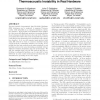Free Online Productivity Tools
i2Speak
i2Symbol
i2OCR
iTex2Img
iWeb2Print
iWeb2Shot
i2Type
iPdf2Split
iPdf2Merge
i2Bopomofo
i2Arabic
i2Style
i2Image
i2PDF
iLatex2Rtf
Sci2ools
GECCO
2005
Springer
2005
Springer
Evolving analog controllers for correcting thermoacoustic instability in real hardware
Previous research demonstrated that Evolvable Hardware (EH) techniques can be employed to suppress Thermoacoustic (TA) instability in a computer simulated combustion chamber. Though that work established basic feasibility, there were still significant questions concerning whether those techniques would function in the real world. This paper presents the results of the next incremental step between controlling in pure simulation and controlling a real combustion chamber. In it, we will examine issues involved with using EH methods to learn to control a hardware analog circuit model of a combustion chamber. In so doing, we establish that the basic methods work when interfaced to real hardware and uncover some interesting, potentially critical, differences between simulation and real environments. We will also establish that both the EA methods and the underlying reconfigurable hardware can be expected to learn effectively in noisy control environments and that they are well-suited f...
| Added | 27 Jun 2010 |
| Updated | 27 Jun 2010 |
| Type | Conference |
| Year | 2005 |
| Where | GECCO |
| Authors | Saranyan Vigraham, John C. Gallagher, Sanjay K. Boddhu |
Comments (0)

